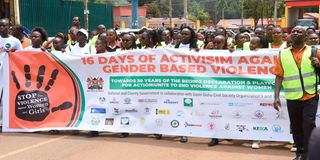Beyond the 16 Days of Activism: Why silent men are GBV's greatest enablers

Participants during the launch of 16 Days of Activism against Gender-Based Violence in Eldoret, Uasin Gishu, on November 25, 2024.
What you need to know:
- Men are both the primary perpetrators and potential key solutions to GBV, particularly in practices like FGM and child marriages.
- According to the social norms theory, even men uncomfortable with violence often remain silent due to perceived social pressures.
- Men who actively combat GBV are transforming counter-norms into new norms, creating essential role models and demonstrating that taking action against violence is possible.
During the 16 days of Activism against gender-based violence (GBV) that ended on December 10, Nation Media Group featured illustrious men tackling different forms of GBV, particularly retrogressive practices such as female genital mutilation (FGM) and child marriages. This is as it should be, based on the theory that if you are part of a problem, you must be part of the solution.
Recurrent data show that men are the majority perpetrators of violence. They are also the primary beneficiaries of the retrogressive practices. FGM would not be alive if men did not demand women who have gone through the rite.
The main philosophy behind FGM is that it reduces female libido. Thus the men who support it do so for the reason that it gives them peace of mind that their wives are faithful. Child marriages would also be extinct if men did not give out and accept girls for wives.
The involvement of men in violence and their engagement in combating it can be understood through the social norms theory byAlan Berkowitz and Wesley Perkins (1986) which states that “our behaviour is influenced by incorrect perceptions of how other members of our social groups think and act”.
In short, even though some men may be uncomfortable with violence, they do not act on or express discomfort about it. As a result, they perpetrate such acts by omission.
The social norms theory is derived from the sub-culture of violence theory proposed by Marvin Wolfgang and Franco Ferracuti. A sub-culture is defined as “a normative system of some group or groups smaller than the whole society”.
The sub-culture follows “conduct norms” which govern “the various ways in which a person might act under certain circumstances”.
The first tenet of the theory states that no sub-culture can be totally different from or fully in conflict with the society which it is part of. This implies that violence arises from and is instrumental in maintaining an underlying societal ideology and practical system.
But the ideology may not be expressed by all its beneficiaries in a similar way. This is the point of the second tenet, that to establish the existence of a subculture of violence does not require that the actors sharing in these values always be violent. Thus even though many men subscribe to the ideology, not all of use violence; and even those who do are not violent all the time.
What triggers and sustains the use of violence is the point in the third tenet, that willingness to resort to it results from internalisation of the norm. But is there then a discernible pattern in categories of people who use violence?
The fourth tenet addresses this issue and implies that majority of perpetrators of violence are likely to be found in specific demographic categories such as particular generations, social classes and neighbourhoods.
The fifth tenet, and a critical one in locating men’s anti-violence crusades, states that the counter-norm is non-violence.
If violence has been widely accepted as a way of expression by members of a sub-culture, those who do not use it stand out as socially odd. Thus it takes conscious deliberate effort to be different, for doing so may breed stigma and social isolation by conservatives.
The sixth tenet states that the development of favourable attitudes usually involves a process of deferential learning, association or identification.
This posits that violence is not a natural impulse and can be avoided consciously through re-learning and adoption of new norms of non-violence.
Read: A father's horror: How poverty and religious manipulation enabled years of child abuse in Kilifi
The final tenet notes that the use of violence in a subculture is not necessarily viewed as illicit conduct and the users therefore do not have to deal with feelings of guilt about their aggression.
In a system that accepts violence as legitimate expression, therefore, it does not arouse outrage and is easily ignored and tolerated. The men combating violence are saying that it should not be accepted or justified in any way under any circumstance.
They are demonstrating by example that men as individuals and groups should and can take action against violence even if they may look odd initially.
Overcoming the inhibition to stand up to be counted is an enormous step towards not only liberation of women from the vice but also of men from the guilt of inaction on a scourge that is very costly socially and economically to families, communities and the whole nation.
Critical in this continuum is that such men create new role models and hopefully influence peers to nurture a violence-free society. According to the sub-culture of violence theory, these men are transforming the counter-norm into the norm, a trajectory that must be fully endorsed.
The writer is a lecturer in Gender and Development Studies at South Eastern Kenya University ([email protected]).





